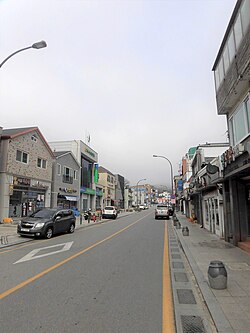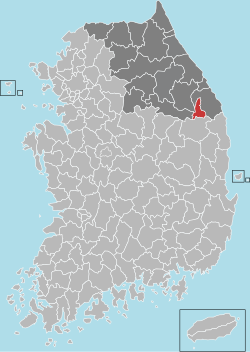Taebaek (Korean: 태백; Korean pronunciation: [tʰɛ̝.bɛ̝k̚]) is a city in Gangwon province, South Korea. Its name is shared with that of the Taebaek Mountains. Situated at an elevation of 650 to 700 m (2,130 to 2,300 ft), Taebaek is the second highest city in South Korea, after Yongin.
Taebaek 태백시 | |
|---|---|
| Korean transcription(s) | |
| • Hangul | 태백시 |
| • Hanja | 太白市 |
| • Revised Romanization | Taebaek-si |
| • McCune-Reischauer | T'aebaek-si |
 | |
 Location in South Korea | |
| Coordinates: 37°10′N 128°59′E / 37.167°N 128.983°E | |
| Country | |
| Region | Gwandong |
| Administrative divisions | 8 dong |
| Area | |
| • Total | 303.53 km2 (117.19 sq mi) |
| Population (2023) | |
| • Total | 38,918 |
| • Density | 185/km2 (480/sq mi) |
| • Dialect | Gangwon |
| Climate | Dwb |
Etymology
editTaebaek in is derived from Taebaeksan Mountain, meaning "very bright."[1]
Attractions
editManggyeongsa Temple in Hyeol-dong, at an elevation of 1,460 meters on the Taebaek Mountains, is a temple built to enshrine the statue of the Bodhisattva of wisdom. It was built by Jajang, a Silla Dynasty monk. The "Dragon Spring" at the entrance of the temple is known as the highest spring in Korea.[2]
Climate
edit| Climate data for Taebaek (1991–2020 normals, extremes 1985–present) | |||||||||||||
|---|---|---|---|---|---|---|---|---|---|---|---|---|---|
| Month | Jan | Feb | Mar | Apr | May | Jun | Jul | Aug | Sep | Oct | Nov | Dec | Year |
| Record high °C (°F) | 12.2 (54.0) | 20.1 (68.2) | 21.6 (70.9) | 29.7 (85.5) | 32.6 (90.7) | 35.0 (95.0) | 35.7 (96.3) | 35.6 (96.1) | 31.8 (89.2) | 26.9 (80.4) | 22.6 (72.7) | 15.2 (59.4) | 35.6 (96.1) |
| Mean daily maximum °C (°F) | 0.7 (33.3) | 3.1 (37.6) | 7.9 (46.2) | 15.1 (59.2) | 20.8 (69.4) | 24.0 (75.2) | 25.9 (78.6) | 26.0 (78.8) | 21.5 (70.7) | 16.8 (62.2) | 9.9 (49.8) | 3.0 (37.4) | 14.6 (58.3) |
| Daily mean °C (°F) | −4.7 (23.5) | −2.5 (27.5) | 2.4 (36.3) | 8.9 (48.0) | 14.5 (58.1) | 18.1 (64.6) | 21.4 (70.5) | 21.3 (70.3) | 16.2 (61.2) | 10.5 (50.9) | 4.2 (39.6) | −2.3 (27.9) | 9.0 (48.2) |
| Mean daily minimum °C (°F) | −9.6 (14.7) | −7.8 (18.0) | −2.9 (26.8) | 2.9 (37.2) | 8.4 (47.1) | 12.9 (55.2) | 17.7 (63.9) | 17.7 (63.9) | 11.7 (53.1) | 5.0 (41.0) | −0.9 (30.4) | −7.1 (19.2) | 4.0 (39.2) |
| Record low °C (°F) | −21.7 (−7.1) | −20.3 (−4.5) | −16.8 (1.8) | −8.2 (17.2) | −2.1 (28.2) | 0.5 (32.9) | 5.6 (42.1) | 8.3 (46.9) | 1.0 (33.8) | −7.1 (19.2) | −15.2 (4.6) | −18.5 (−1.3) | −21.7 (−7.1) |
| Average precipitation mm (inches) | 26.6 (1.05) | 28.8 (1.13) | 54.8 (2.16) | 85.8 (3.38) | 90.2 (3.55) | 140.4 (5.53) | 274.2 (10.80) | 278.7 (10.97) | 198.4 (7.81) | 65.5 (2.58) | 45.2 (1.78) | 19.4 (0.76) | 1,308 (51.50) |
| Average precipitation days (≥ 0.1 mm) | 7.2 | 6.5 | 9.9 | 9.5 | 9.0 | 11.2 | 16.3 | 16.0 | 12.0 | 7.2 | 8.1 | 6.2 | 119.1 |
| Average snowy days | 10.7 | 9.7 | 9.9 | 2.1 | 0.0 | 0.0 | 0.0 | 0.0 | 0.0 | 0.5 | 3.3 | 7.6 | 44.0 |
| Average relative humidity (%) | 59.1 | 58.4 | 59.2 | 55.4 | 59.4 | 71.2 | 78.3 | 79.9 | 79.3 | 70.5 | 63.6 | 58.4 | 66.1 |
| Mean monthly sunshine hours | 174.9 | 178.3 | 202.7 | 207.2 | 232.9 | 192.7 | 143.8 | 141.7 | 147.4 | 178.7 | 159.6 | 169.8 | 2,129.7 |
| Percent possible sunshine | 54.0 | 56.2 | 53.4 | 54.6 | 50.4 | 42.8 | 30.5 | 39.5 | 48.8 | 57.4 | 51.6 | 53.4 | 48.6 |
| Source: Korea Meteorological Administration (snow and percent sunshine 1981–2010)[3][4][5] | |||||||||||||
Transportation
edit
Sister cities
editSee also
editReferences
edit- ^ "Origin of Taebaek". TAEBAEK-SI.
- ^ Cin Woo Lee "Simply stunning: 33 incredible Korean temples" Archived 2012-04-17 at the Wayback Machine CNN Go. 10 February 2012. Retrieved 2012-04-12
- ^ "Climatological Normals of Korea (1991 ~ 2020)" (PDF) (in Korean). Korea Meteorological Administration. Archived from the original (PDF) on 29 January 2022. Retrieved 4 April 2022.
- ^ 순위값 - 구역별조회 (in Korean). Korea Meteorological Administration. Retrieved 4 April 2022.
- ^ "Climatological Normals of Korea" (PDF). Korea Meteorological Administration. 2011. Archived from the original (PDF) on 7 December 2016. Retrieved 8 December 2016.
External links
edit🔥 Top keywords: Akademia e Shkencave e RPS te ShqiperiseAlexandria Ocasio-CortezBilderberg GroupCristiano RonaldoDong XiaowanMinecraftOperation GladioPrimal cutRiot FestStrictly Come Dancing (series 7)Main PageSpecial:SearchWikipedia:Featured picturesJayson TatumJuneteenthUEFA Euro 2024Jaylen BrownAl HorfordBoston CelticsJoe MazzullaList of NBA championsCristiano RonaldoHouse of the DragonPage 3Noam ChomskyJrue HolidayCleopatraDeaths in 2024.xxxArda GülerPepe (footballer, born 1983)Inside Out 2Georgia (country)MāuiBo DallasBridgertonUEFA European ChampionshipCzech RepublicJustin Timberlake2024 NBA FinalsYouTubeFrancisco ConceiçãoKristaps PorziņģisThe Boys (TV series)Chad GableRoberto MartínezNoam chomskyDerrick White (basketball)Anouk Aimée


